Mushrooms are some of the most magical and medicinal beings on the planet–they are in their own kingdom, and are related more closely to us than to plants or trees! I’ve been doing a deep dive into the study of the fungi realms in the last few years, including working extensively with their medicine, their magic, and learning the finer points of foraging, identification, and growing mushrooms. As much as I’ve learned, I realize there is still so much to learn!

But one of the most important things to me right now is finding hope in an increasingly hopeless situation. As Paul Stamets has shared, mushrooms have the power to save the planet! This includes cleaning up pollution and polluted soil (including some very toxic substances), making insecticides from fungus rather than toxic chemicals, treating a host of diseases (flu, cancer, diabetes, etc) and generally restoring our ecosystems. When I work with mushrooms, especially their physical and spirit medicine, I feel this potential. I feel the hope that mushrooms offer us, the medicine, the connection. So today, I’m going to talk about my very favorite mushroom, one that actually brought me to the druid path and taught me some of the most important lessons on the healing of nature: Ganoderma Tsugae, the Reishi or Hemlock Varnish Shelf. This is an incredible medicinal mushroom that is relatively easy to find and easy to identify. There are Reishis that grow across the world, so even if yours is different, the research I’m offering on Reishi today I would say that if you are interested in learning about mushroom medicine, you could start no better place than with the Reishi or Turkey Tail (which I’ll cover soon)! I also think if you are going to be taking only one healing plant or mushroom medicine, Reishi is an outstanding choice. In today’s post I’ll share all bout my favorite mushroom, the Hemlock Reishi: history, how to find and prepare Reishi, healing properties and medicinal information, my own experiences, and especially–the part you won’t find on other sites–how to work with this mushroom spiritually and my observations surrounding the metaphysical aspects of Reishi. I will also say that I’m writing this in 2024, and there is a growing Western scientific interest in Reishi and other medicinal mushrooms. Every year 300+ articles are published on Reishi alone, so new discoveries are always being made and folk wisdom continues to be confirmed again and again with this incredible mushroom.
Are Different Reishi’s Interchangeable from a Medicinal Standpoint?
One question that people sometimes ask is about the different Reishi species and their medicinal qualities. Most of the research on Reishi focuses on Ganoderma Lucidum, from Asia, which has a 4000-year history of use in Traditional Chinese Medicine. However, according to Jerry Angelini, who is the Head of Science Education at Fungi Perfecti and Host Defense, our local Reishi has the same compounds as other Ganodermas, including the Reishi ‘Lingzhi’ Ganoderma Lucidum. My sister Briel and I were able to take a workshop from him some years back at the American Herbalist Guild Association meeting and learn about his cutting-edge research on North American Reishi species–and clarify this exact question!
Finding Reishi
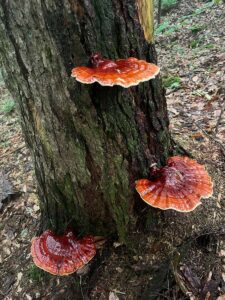
The US East Coast Ganoderma Tsugae Reishi is a white-rot saprophyte, meaning that Reishi grows primarily on dead hemlocks but occasionally as a parasite on living hemlock trees (Tsugae Canadensis). You have the most luck in finding Reishi by visiting either forests that have been logged 5-15 years prior that had Reishi (check the stumps) or in old-growth or second-growth forests with Hemlocks that are allowed to fall naturally. I will also note that in the southern part of her range (which is where I live), Eastern Hemlock in our region is found more frequently in bottom areas, wet/damp forests, near springs or creeks, near forested rivers. In northern areas, you will find Eastern Hemlock more broadly. I will also note that we are losing a lot of Eastern Hemlocks to the Hemlock Wooly Adelgid, so areas that may have been affected but still have dead Hemlocks will also be good candidates for Reishi. Reishi are characterized by their white underside that has thousands of tiny pores (they are a polypore shelf mushroom). When they are edge, they have an outer band of white moving into yellow, orange and dark red. As they age, they turn dark red all over but still have a white underside with millions of pores. They can get up to 12” across. They have a lovely rusty brown spore print. When you find one, check to see if they are still medicinal quality (e.g. they are still white underneath and don’t have a ton of bug damage). Harvest these in June or early July, before the bugs take them over. If you find that your reishi has some bugs, that’s really quite common. I usually cut the bugs out and then put them back with that chunk of mushroom in the forest.
Rich Reishi History
Reishi is an incredible mushroom with a rich history with over 4000 years of documented use in China. The Chinese call Reishi “Lingzhi” in Mandarin. It is prounouced LING-GI. It means “Herb of spiritual potency.” I love this name because I do think that Reishi is a very spiritually potent mushroom. To show the reverence the Chinese have for Reishi and the medicinal power of this mushroom, here are two quotes:
´“Lingzhi is a miraculous king of herbs”—Chinese people (221–206 BC).
“If eaten customarily, it makes your body light and young, lengthens your life, and turns you into one like the immortal who never dies.” -´Shennon Ben Cao Jing (Materia Medica) (206BC – 220 AD)
While this Chinese history is the most well-documented, I do not doubt that indigenous people around the world use this wonderful mushroom–and many modern people today are finding the wonderful healing of Reishi for a wide range of conditions.
Reishi: The Mushroom of Immortality
The research on Reishi mushrooms is very extensive, and you will quickly see why the Chinese call this the “Mushroom of Immortality.” Beuhner’s Herbal Antibiotics gives an excellent synthesis of the research on Reishi; he notes that at present over 400 bioactive constituents have been identified in Reishi including some Ganoderma species-specific compounds! Reishi has vitality-enhancing, tonic, and longevity effects. This research includes the following (and new studies and research are continuing to be done, with many new studies appearing all the time):
- Analgesic: Reishi is offers pain relief
- Antiallergenic: Reishi offers allergy relief and offers antihistamine qualities
- Antibacterial and Antiviral: Reishi offers an anti-microbial, systemic action against both bacteria and viruses to support healthy immune system functioning
- Toxin and Poison support: Reishi strengthens the kidney after the kidneys have been subject to toxic chemicals or medicines. Matthew Wood notes Reishi’s usefulness in treating mushroom poisoning (with specific impact against the Death Cap, Amanita Phaloides.)
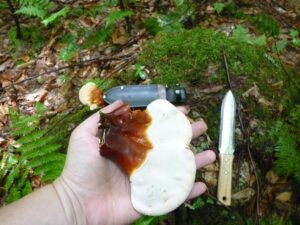
Reishi harvest! - Liver support: Reishi has a broad positive impact on the liver including promoting liver regeneration, and having a specific impact on the compound Bilirubin, which is often in excess when jaundiced, Anemic, having Gilbert’s syndrome, or other liver conditions
- Heart and cardiovascular support: Reishi reduces the levels of triglycerides in the blood which leads to heart disease. High triglycerides are caused by diet, obesity, sedentary lifestyle, medical conditions, overconsumption of alcohol and/or genetics. Reishi also lowers blood pressure and cholesterol in the blood.
- Coronary vasodilator: Additionally, Reishi causes the blood vessels of the heart (the coronary arteries) to widen and dilate, which increases blood flow to the heart; Reishi can also be used to treat Angina (chest pain) or other heart conditions.
- Cancer-fighting: Reishi is cytotoxic, that is, the mushroom inhibits the growth of cancer cells. There are many different clinical trials with Reishi as part of cancer treatment (along with the wonderful Tramates Versicolor, the Turkey Tail, which is the #1 fighting cancer mushroom).
- Immune regulator: Reishi is an immunomodulator, which helps regulate the immune system. Our immune systems protect the body against infection and disease and determine how quickly we recover when we are sick. Reishi can enhance or suppress immune function and bring it back into healthy balance (hence the “modulation”).
- Spleen and Thymus tonic: The Spleen and Thymus are glands that are vital components to the immune system. The spleen plays a role in filtering blood, removing old and damaged blood cells, and creating immune cells. The thymus is responsible for creating T lymphocytes, a white blood cell for immune function. Reishi is tonic to these glands, nourishing and supporting their well-functioning.
- Nervous system support: Reishi has a tonic effect on the parasympathetic nervous system (the system tied to rest, digestion, sleep, and dreaming) and is tonic for the adrenal cortex which supports the parasympathetic. Thus, Reishi can nourish your nervous system and help you reduce stress and rest.
Reishi is contraindicated for those who are pregnant, breastfeeding, or on anti-coagulants or other heart medications.
Preparing Reishi: A Double Extracted Tincture
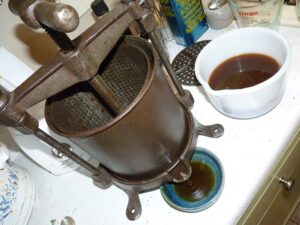
One of the challenges with mushroom herbalism is that not all of the mushroom constituents are bioavailable – if you take this as capsules or a tea you are not getting the full effect. Thus, you need to create a double-extracted tincture (which I detail in much more detail here). Briefly: the tincture should first be made of high-proof alcohol (here in PA, that is a 150-proof grain alcohol, like Everclear), then after 1 month of macerating the Reishi, you strain the Reishi tincture and begin the water extraction with the same material. Thus, you do a 3-day hot water extraction (using a crock pot and making a strong tea) and then do a 3-day cold water extraction (putting the liquid in the fridge). At this point, you can use a distillation calculator to bring your Reishi double-extracted tincture to 40% (here is one such calculator). While this double extraction takes time, it allows you to get the full medicinal benefit! Further, you are also able to make a large amount of double-extracted tincture at once, and it has infinite shelf life. I will also say that Reishi has a very strong taste. A double-extracted tincture does not exactly taste great (although some people tolerate the taste more than others). Adding a bit of honey or maple syrup to the blend can be really helpful. You can also dilute the tincture–I put it in a shot glass, sometimes add a bit of honey, and then add water to fill the glass. Then I do my daily shot of Reishi!
My Experiences Taking Reishi as Medicine
I have been taking Reishi every day for many years (as part of a daily herbal blend) and my entire body feels good when I take it. If I miss a day or two, it is usually fine. But if I miss a week or more, I can majorly tell the difference—my muscles after working on the homestead are much more sore and achy. As soon as I take my Reishi again, my muscles go back to feeling good, and I can tolerate things like sleeping on hard surfaces and much much longer. I have found that Reishi definitely helps me get a more reasonable baseline with my stress levels, especially “modulating” the stress and keeping me away from emotional extremes. It’s almost like it takes more to get me into a stressful state when I am taking my Reishi regularly. I also can manage my pet-related and seasonal allergies much better. Without Reishi, I am often stuffed up due to our cats–but with Reishi and my dear friend Stinging Nettle, the allergies go away and I can breathe. At the same time, I know that Reishi is fighting free radicals in my body and keeping me from getting cancer; Reishi is strengthening my cardiovascular system (and heart issues run in my family, so this is critically important), and all the other amazing things that Reishi does. Each time I take my Reishi (generally right before bed), I take a moment to give my thanks to this magnificent healing mushroom–and the fact that she regularly puts herself in my path so that I might have this incredible medicine. She is deserving of our love, respect, and honor.
Nourishing the Spirit and Putting on your Reishi Armor
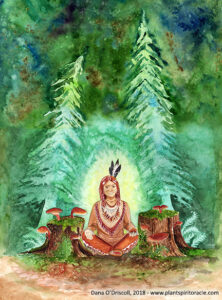 I have worked with the spirit of the Reishi mushroom for a long time. You can see one of my depictions of Reishi in the Plant Spirit Oracle. This is actually how I first met Reishi. As spirit beings, mushrooms are trickier to work with than trees or plants, but they are potent allies. When I first met Reishi, I experienced a similar scene–finding Reishi on the trees that had been cut down in my beloved forest. Here was this forest, pillaged and logged by humans again and again across three centuries. She responds by growing one of the most medicinal mushrooms and potent healers in the natural world. I was with a friend who knew more about mushrooms than I did, and he excitedly pointed out the features of Reishi. I harvested them and learned to prepare them as medicine–this was now over a decade ago, but that experience always stuck with me and really got me interested in mushrooms as part of herbalism practice.
I have worked with the spirit of the Reishi mushroom for a long time. You can see one of my depictions of Reishi in the Plant Spirit Oracle. This is actually how I first met Reishi. As spirit beings, mushrooms are trickier to work with than trees or plants, but they are potent allies. When I first met Reishi, I experienced a similar scene–finding Reishi on the trees that had been cut down in my beloved forest. Here was this forest, pillaged and logged by humans again and again across three centuries. She responds by growing one of the most medicinal mushrooms and potent healers in the natural world. I was with a friend who knew more about mushrooms than I did, and he excitedly pointed out the features of Reishi. I harvested them and learned to prepare them as medicine–this was now over a decade ago, but that experience always stuck with me and really got me interested in mushrooms as part of herbalism practice.
I also think that Reishi’s Chinese name, “Lingzhi” is an important clue to the mushroom’s metaphysical nature and metaphysical healing possibilities. The mushroom has tremendous healing power for the physical world, but also, clearly, the Chinese believe in the healing of the spirit based on this mushroom. I have experienced this with Reishi–as a mushroom ally, she helps strengthen and protect my spirit. It is almost like Reishi gives me a set of spiritual protective armor so that I can handle the worlds within and without better. And right now, we all need as much protection and strength as we can get.
The world is challenging and, these days, I feel like so many things are a battle: enduring climate change and the smoke, heat, droughts, or whatever else; while doing this keeping my heart and spirit in a positive place; while doing this still going to my job, watching my entire industry spiral down quickly and in a very draining manner; while also dealing with everything else. Yeah. So when I take my daily Reishi tincture, I feel like she is just helping me put on a suit of armor. Now when I go out, I have an extra bit of defense–that first blow isn’t going to take me out. I can handle more, but still feel everything. It is like my capacity to endure grows. And let me tell you, this is a really good thing because without that kind of protection can really help me handle the world better. So many unexpected things happen and they are all hard. And being an animist, a druid, an earth-aware person is hard as hell right now, and I am so grateful to have mushroom allies who walk with me and strengthen me through the darkness and keeps me going. A big reason I wanted to write this post is to share this exact thing. I think a lot of us could use this kind of protection now. I really believe that herbs, trees, and mushrooms are fantastic to learn and work with on a nature-based spiritual path. And there are lots of plants and mushrooms who might offer protection, nourishment, and strength to you. My suggestion is that you might try out a number of our potent plant and mushroom healers for this kind of spiritual protection, and see which one(s) work best for you. When we need her, Reishi is here for us.
Closing
I hope that this introduction to the incredible Reishi, Ganoderma Tsugae, has peaked your interest not only about Reishi but other mushroom and plant healers. We all can use as much healing and support as we can get right now–and these allies are ready to stand with those who stand with the land. They are ready to show up for you, because you are already showing up for them.
Announcements:
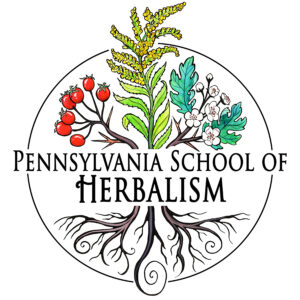 Speaking of medicinal mushrooms and Reishi, I will be presenting a free hour class on medicinal mushrooms and how to make a double-extracted tinctures at the Western Pennsylvania Mushroom Club July meeting this week on Tuesday, July 16th in Pittsburgh (details and location here). Additionally, I have a few other classes on the schedule for the summer if you live in the Mid-Atlantic US region: July 16th: 7pm: Medicinal Mushrooms and Double-Extracted Tinctures. Pittsburgh, PA. Frick Environmental Center. Free class for the Western PA Mushroom club (open to the public). July 28th: 930-2:30pm: Second Foundations of Holistic Herbalism Series through the Pennsylvania School of Herbalism. I’ll be team teaching this with my sister with Briel Beaty and Dana O’Driscoll. This class will cover herbal energetics though hands-on experience. We will cover the basics of the immune system and nervous system and how they relate to our herbal practice. We will learn how to properly dry herbs and make herbal teas.
Speaking of medicinal mushrooms and Reishi, I will be presenting a free hour class on medicinal mushrooms and how to make a double-extracted tinctures at the Western Pennsylvania Mushroom Club July meeting this week on Tuesday, July 16th in Pittsburgh (details and location here). Additionally, I have a few other classes on the schedule for the summer if you live in the Mid-Atlantic US region: July 16th: 7pm: Medicinal Mushrooms and Double-Extracted Tinctures. Pittsburgh, PA. Frick Environmental Center. Free class for the Western PA Mushroom club (open to the public). July 28th: 930-2:30pm: Second Foundations of Holistic Herbalism Series through the Pennsylvania School of Herbalism. I’ll be team teaching this with my sister with Briel Beaty and Dana O’Driscoll. This class will cover herbal energetics though hands-on experience. We will cover the basics of the immune system and nervous system and how they relate to our herbal practice. We will learn how to properly dry herbs and make herbal teas.
13th: Backyard Herbalism and Medicine Making. With Dana O’Driscoll. August 13th, 5-7pm. (Indiana County, located 15 min from Indiana, PA). In this 2-hour hands-on class, you will be introduced to the most common lawn and garden plants that are found in almost every lawn or garden in Pennsylvania. We will specifically cover plant identification, harvest, their medicinal uses (material medical), and learn how to make a range of basic plant medicines including a backyard healing salve, jewelweed-infused witch hazel for poison ivy, and stomach-ease tea. Students will be able to take three herbal creations home with them.
24th: 830-4pm Women’s Herbal Retreat: Join Briel and Dana of the Pennsylvania School of Herbalism for a Women’s Herbal Retreat Day at Rhoneymeade in Centre Hall, PA (Central PA). All those who identify as a woman are welcome to join us. We will spend the day drinking herbal tea and learning about plants to support women at all stages of life. In addition to our herbal focus, we will have yoga, breathing, and meditation practices throughout the day. You will get to make and take a customized herbal tea and face spritzer to go home with you and we will have some fun herbal drinks and treats to share. At Rhoneymeade in Centre Hall, PA. The schedule for this event is here. Sliding Scale $65-95
References Buhner, S. H. (2012). Herbal antibiotics: natural alternatives for treating drug-resistant bacteria. Storey Publishing, LLC. El Sheikha A. F. (2022). Nutritional Profile and Health Benefits of Ganoderma lucidum “Lingzhi, Reishi, or Mannentake” as Functional Foods: Current Scenario and Future Perspectives. Foods (Basel, Switzerland), 11(7), 1030. https://doi.org/10.3390/foods11071030 Wood, M. (2009). The Earthwise Herbal, Volume II: A Complete Guide to New World Medicinal Plants. North Atlantic Books.
24th: 830-4pm Women’s Herbal Retreat: Join Briel and Dana of the Pennsylvania School of Herbalism for a Women’s Herbal Retreat Day at Rhoneymeade in Centre Hall, PA (Central PA). All those who identify as a woman are welcome to join us. We will spend the day drinking herbal tea and learning about plants to support women at all stages of life. In addition to our herbal focus, we will have yoga, breathing, and meditation practices throughout the day. You will get to make and take a customized herbal tea and face spritzer to go home with you and we will have some fun herbal drinks and treats to share. At Rhoneymeade in Centre Hall, PA. The schedule for this event is here. Sliding Scale $65-95
References Buhner, S. H. (2012). Herbal antibiotics: natural alternatives for treating drug-resistant bacteria. Storey Publishing, LLC. El Sheikha A. F. (2022). Nutritional Profile and Health Benefits of Ganoderma lucidum “Lingzhi, Reishi, or Mannentake” as Functional Foods: Current Scenario and Future Perspectives. Foods (Basel, Switzerland), 11(7), 1030. https://doi.org/10.3390/foods11071030 Wood, M. (2009). The Earthwise Herbal, Volume II: A Complete Guide to New World Medicinal Plants. North Atlantic Books.
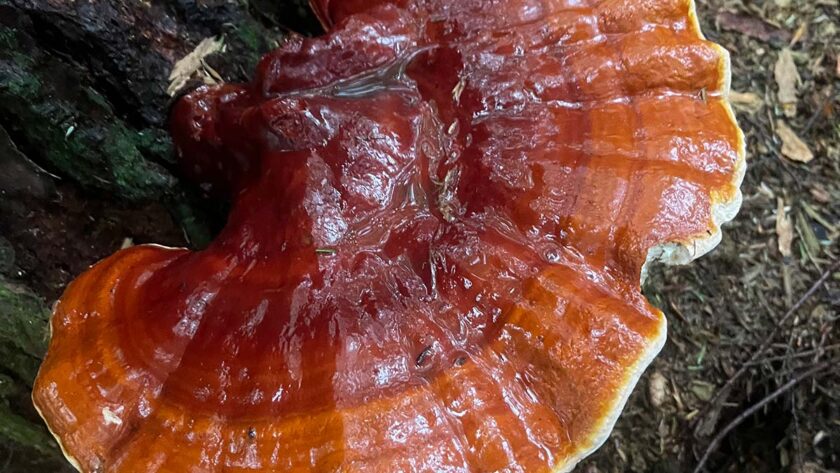
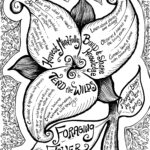

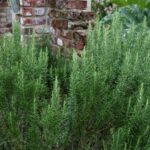
So I have some dried reishi that is 4 years old. Is it too old to make a tincture like this?
Hi Jillian,
I have found that mushrooms have a pretty long shelf life if stored properly. If you have stored them in a cool, dry place in a sealed jar, they should be fine. Take a look at your mushroom matter: does it still look viable? Does it still look white underneath, can you still see the brown tubes and does it still have a strong smell? If so, you are probably fine to use it :). I generally go for a 5 year shelf life on mushrooms, although I try to tincture them within a year or two if possible.
Hi Dana,
Two thoughts after reading this:
1) The link for the “here is one such calculator” line doesn’t show up / work for me. Will you please re-check / re-post?
2) If I remember right, you work in higher education/university. I have two YA kids in college, and I see all the stresses on/in the current system. I’d be interested in future blog post(s) with your thoughts on your work experiences, and also how we might re-envision a transition to a more sustainable and nature-attuned educational system, including “higher” education. (I recognize this is a big ask….perhaps keep it high-level? :-P)
Blessings.
Hi Janet,
I’ve updated the link! Thanks for catching that!
And ooohhh boy, I could certainly say a lot about higher ed, but it might be pretty radical, lol! In a nutshell, I think that the entire education system (especially primary and secondary school) is founded on some pretty concerning principles–it basically prepares people to be factory workers, with bells and discipline and everything. That’s the actual model if you trace it back far enough. Tyson Yunakporta describes this history quite well in Sand Talk. I used to think that higher education was different, but I am now coming to understand that it is founded on the same principles, and when times get tight, all of the higher ideals are stripped away and we are left with yet another industrial and corporate system without equity and with a host of problems. The experience of about the last five years is actually leading me to a bit of a crisis of ethics at the moment. I value higher education, and I value so much my time as both a student and as a faculty member. But right now, higher ed is in crisis for a lot of reasons, and certainly I have experienced quite a bit working at two different state institutions (I work at a state institution now that grants doctoral degrees and is considered high research activity / R2). I am pretty much blown away by what I’m seeing now. And I think AI is going to be the thing that brings down a lot of the current higher ed system…. But I don’t know how longer public education as it is now will last. I DO have a lot to say about sustainable and nature-attuned education systems but I’ll have to get my thoughts in order before sharing it.
Just catching up after a week away. Thanks for the synopsis. I agree about the industrial model…I actually partially homeschooled my kids K-8 at a wonderful public hybrid program in WA State (they attended classes run by local public school one – two days/week). They each went to public high school – my youngest just graduated – and I’ve watched the (further) decline over the last 7 years. I firmly support both public education and higher education….but both systems are under such enormous strain(s) that they are no longer really working, certainly not well. It is a good time to re-envision!
Hi Janet – I think that’s a good way to put it–the systems are under a lot of strain and are not really working well. I don’t really know what that means for education long-term, but I’m hopeful as people are flocking to our new herb school we opened this year, and flocking to all kinds of other opportunities to learn from each other. There is a yearning out there for nature-centered knowledge and that brings me joy :).